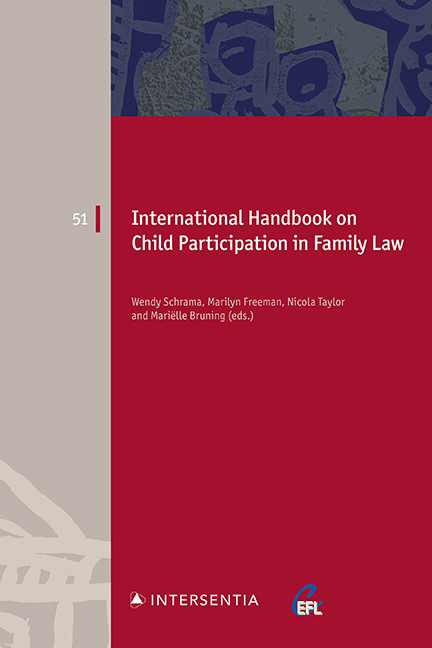Book contents
Child Participation in Family Law Proceedings Compared
Published online by Cambridge University Press: 10 December 2021
Summary
INTRODUCTION
Ammar, a 14-year-old living in Germany, just found out his parents are going to divorce. On the other side of the world, Hannah is going through the same. They meet online and start messaging. One of their shared worries is whether they will get to have a say in the whole ordeal. If so, does Hannah in Australia have the same options as Ammar in Germany? In this chapter, not only Hannah and Ammar's participation rights are compared, but also those of children in 15 other countries.
The present Handbook is a rich comparative resource. The chapters for each of the jurisdictions grant an insight into the different manners in which children, such as Ammar and Hannah, can participate in family law proceedings. The current chapter provides a comparative analysis of the jurisdictions covered in this Handbook and serves as a springboard for further comparative research. The similarities and differences between the various modes of participation available to children in the 17 jurisdictions will be discussed.
This comparative analysis focuses on a number of key themes regarding child participation. First, the types of proceedings addressed in this comparison are introduced. Then the core focus of the comparison shifts to the modes of participation. Can Hannah speak directly to the judge? Is it possible for Ammar to have a lawyer appointed to represent him? The different domestic opportunities available to children per mode of participation will be compared. Thereafter, two specific proceedings are discussed separately: international child abduction proceedings and alternative dispute resolution processes like mediation. Do children have the same participation opportunities in these proceedings compared to general family law proceedings, or are different opportunities provided? Subsequently, from a more overarching perspective, the requirements for participation will be discussed, as well as the methods of informing the child prior to and after the proceedings. The chapter ends with concluding remarks on the similarities and differences evident from the comparative analysis.
TYPES OF PROCEEDINGS
Whether Ammar and Hannah are dealing with their parents divorcing, or with any other disputes concerning them, it is their right to be able to express their views in all family law proceedings affecting them. As this Handbook is focused on family law proceedings, one may therefore wonder why it is necessary to further discuss the type of proceedings.
- Type
- Chapter
- Information
- International Handbook on Child Participation in Family Law , pp. 335 - 358Publisher: IntersentiaPrint publication year: 2021
- 1
- Cited by



